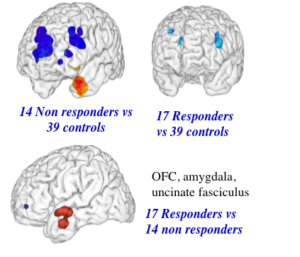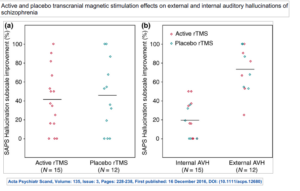Transcranial magnetic stimulation is a non-invasive technique that allows the excitability of the cerebral cortex to be modified locally and transiently. A stimulation coil, placed against the scalp, produces neuronal depolarisation by means of a focused magnetic field.
The work carried out within the unit aims, thanks to functional (PET, fMRI) and/or structural (MRI) imaging, to :
- to optimise and test stimulation methodologies in the experimental treatment of mental disorders in the case of repeated stimulations.
- To gain insight into the pathophysiology of the disorders.
Depression
A method of guiding the coil has been developed to target a specific brain region. For example, in the case of resistant depression, a study showed that repeated transcranial magnetic stimulation (TMS) was more effective by targeting the left pre-frontal regions. Patient characteristics allowed a profile of responders and non-responders to be defined by pre-treatment image analysis alone (Paillere et al, Int. J. Neuropsychopharmacol. 2011).
https://www.ncbi.nlm.nih.gov/pmc/articles/PMC3230494/pdf/npp2011161a.pdf
Schizophrenic hallucinations: TMS targeting language regions was no more effective than placebo. However, the influence of TMS noise varied according to the type of auditory hallucinations.
Language
In healthy subjects, TMS applied to a particular region of the brain (Wernicke’s temporo-parietal area) improves performance on an auditory word detection task, demonstrating the link between Wernicke’s area and auditory processing of language perception and variations in performance depending on the frequency of stimulation (low or high frequency). This information may be useful for the study of pathologies involving language.

